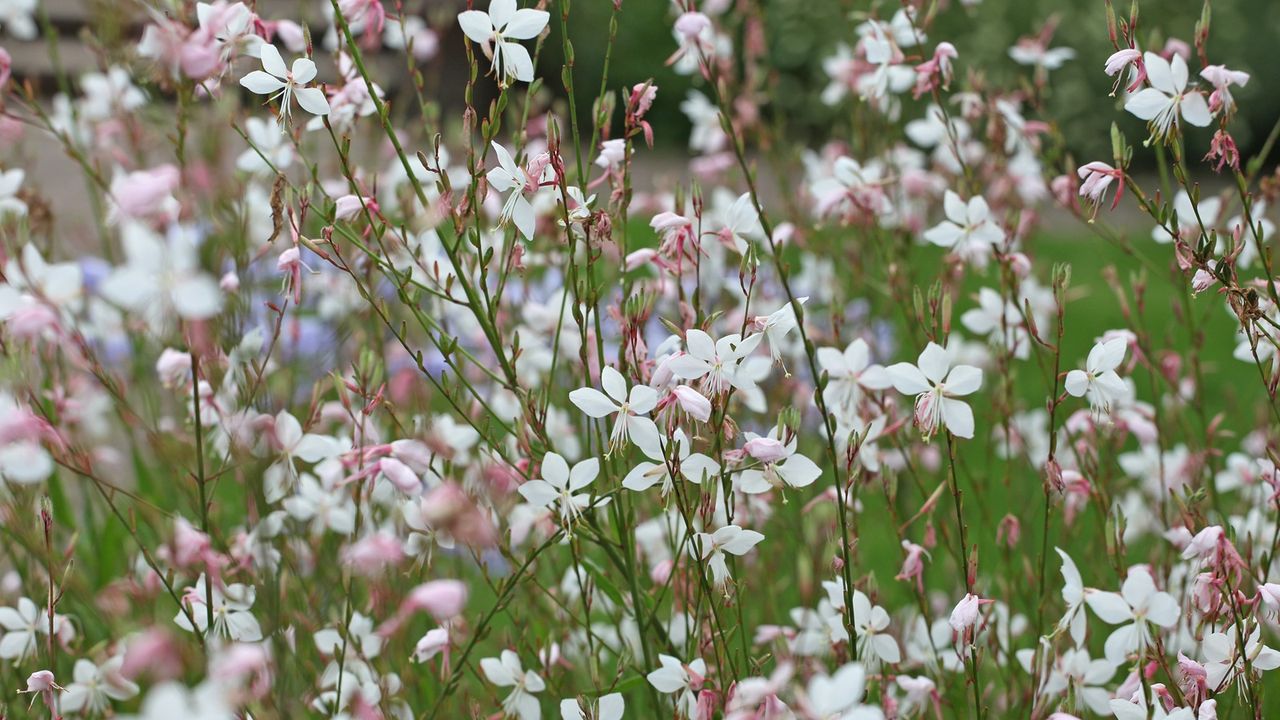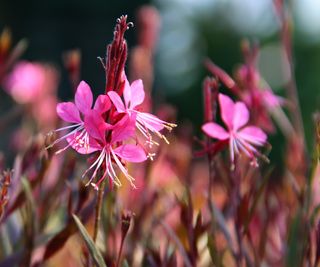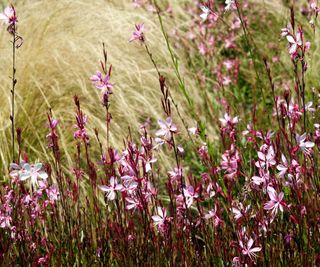How to grow gaura – and boost your yard with glorious, dancing beeblossom
Gaura adds a delicate touch to any summer yard display with its slender, arching stems and endless flowers


Gaura, or Oenothera lindheimeri to give its botanical name, is instantly recognisable for its delicate four-petalled blooms that appear to float ethereally on airy stems. Known by many other names, including whirling butterflies, beeblossom and wand flower, it's a native perennial that is often found gracing roadsides in Southeastern Texas, Louisiana and Mexico.
Sun loving and producing endless blooms from late spring to fall, this surprisingly tough garden favorite often steals the show grown alongside sculptural statements such as agave and cacti or planted in floral drifts weaving through ornamental grasses. Often a mainstay of meadowscaping and other nature inspired planting schemes, gaura lends height, soft texture and a relaxed, graceful movement to any border, pot or gravel garden.
One of the best perennials for any size or style of yard, its well worth exploring the different varieties on offer. From those with variegated foliage, vivid coral petals through to delicate white blooms edged in deep pink, there are plenty of spectacular blooms to inspire.
How to grow gaura for a long lasting floral display
A magnet for butterflies, bees and other pollinators, this hardworking perennial will produce a continuous show of dainty blooms from late spring through to fall.
Gaura is a plant that blooms like a floriferous perennial, but moves like an ornamental grass. It loves full sun, making it a must for western gardens.
Growing habits of gaura

Perennial in USDA hardiness zones 7-9, and best treated as annuals in cooler zones 5-6, these low maintenance plants will thrive happily in full sun but also tolerate some shade.
Preferring well-draining, sandy soil, narrow, lance-shaped leaves emerge in spring followed by a mass of distinctive four petalled blooms spread along fine, wiry stems. This enchanting sight bears a strong resemblance to a flutter of butterflies – hence one popular variety's name 'whirling butterflies'.
Gaura brings plenty of color to the yard with delicately shaded foliage in dark green, burgundy to variegated shades of pink, cream and gold. The long lasting flowers are predominantly white, coral, rose pink through to deep cerise but some varieties are bi-colored typically white petals fringed with pink tones. Be sure to check out this breakthrough Gaura 'Rosy Jane' from Burpee.
‘Some newer hybrids have been bred to more even more floriferous than older hybrids,’ says horticulturalist Justin Hancock. ‘So doing a little research may help you identify which of the varieties you have available will be inclined to bloom the best.’
'No matter which variety you choose, gaura is an excellent perennial for low-maintenance gardens,' says master gardener Tabar Gifford. 'Its delicate, dancing flowers add a touch of whimsy, while its resilience in heat, drought, and poor soils makes it a top pick for pollinator-friendly landscapes.
'Whether you’re drawn to the classic white blooms of 'Snow Fountain', the wild beauty of 'Intermountain Beauty', the rich tones of 'Whiskers Deep Rose', or the vibrant foliage of 'Passionate Rainbow', there’s a gaura variety perfect for every garden.'
Reaching heights of up to 6ft (1.8m) in the wild, cultivated varieties of Oenothera lindheimeri tend to be shorter – anywhere from 18 inches (46cm) to 30 inches (76cm) - making them more manageable for pots and garden borders. High Country Gardens has an enviable range of gaura plants to choose from.

Justin Hancock is a Costa Farms horticulturist with over 25 years in the industry. A plant enthusiast and educator, he has a degree in horticultural science and has worked in garden centers and botanical gardens, as a garden designer, and in garden publishing (including at Better Homes and Gardens). He has experience gardening across the country, from Minnesota to Miami to Oregon. Justin is also co-host of the Costa Farms podcast Plant Rx.
Care guide for gaura

Soil: Native to many southern states, gaura prefers a sunny spot in light, well-draining soil. Soil depth is important as this plant sends down a single long tap root to seek out nutrients which can also help anchor it in exposed locations and, once established, cope with drought.
‘The happier your plant is, the more it blooms,’ shares Justin. ‘Amending your soil with organic matter is often more helpful than fertilizing - there’s a bit of a fine line between good soil and soil that’s too good… in really rich soil, all those nutrients can lead to softer, floppier growth and while it may have lots of flowers, a floppy plant can be less appealing than a plant that’s not flopping and has fewer flowers.’
He also adds, ‘If you have heavy soil or live an area that sees a lot of summer rain, growing your gaura in raised beds or slightly raised mounds can help keep the plant happier and producing more flowers.’
Light: As prairie natives with tough, narrow lance shaped leaves and wiry stems, this tough plant is well adapted to coping with high light levels.
'Gaura is native to dry, open landscapes in the southern US and Mexico, which means it thrives in full sun and well-drained soil,' says Tabar. 'For the best flowering, plant gaura in at least 6-8 hours of direct sun daily. While some varieties can tolerate part shade, they tend to become leggy and produce fewer blooms in lower light.'
Justin also adds, ‘All-day sun is helpful; but if you only have sun for half a day, make sure it’s in the afternoon. You’ll definitely see less performance in morning sun with afternoon shade.’
Watering: To aid root development, water deeply while plants are young, but gradually reduce the frequency after six months to encourage strong, resilient growth and healthy plants.
‘Moist, but well-drained soil is also helpful; while gaura has earned a reputation for being drought tolerant, that means it survives drought but doesn’t mean it thrives in it,’ says Justin.
Fertilizing: Gaura naturally thrives in poor soil so needs little fertilizer. 'Gaura does not need heavy feeding. In fact, excessive fertilization can lead to too much leafy growth and fewer flowers,' explains Tabar. 'Apply a light dose of a balanced, slow-release fertilizer in early spring. For an organic approach, a thin layer of compost in spring can provide essential nutrients. Avoid high-nitrogen fertilizers, which encourage foliage over flowers.' She also adds, 'If growing Gaura in containers, feed lightly with a diluted liquid fertilizer every 4-6 weeks during the growing season.'
Pruning: Cutting gaura back at certain times can encourage extra blooms. Horticultural Expert Laura Root explains, 'To get the most blooms from gaura, cut gaura back by one-third to one-half in early summer to rejuvenate the plant, encourage fresh growth and a flush of new flowers. This keeps their airy blooms going strong through fall. Some modern cultivars, like ‘whirling butterflies’, are bred for prolific blooming and more compact habits - great for containers and small gardens.'
Once stems have turned brown in fall, and ceased flowering, cut them back to 4 inches (10cm) above the ground. If harsh frosts are likely, and you wish to leave these plants in situ, cut back stems in early spring to help protect the plant’s tender crown. These long nosed garden snippers from Walmart make easy work of this task.
Producing a steady display of flowers throughout the warmer months you may think deadheading is not necessary, but Justin shares this advice. ‘Deadheading can be helpful for some varieties (those that aren’t sterile), but either way, it helps the plant look better through the season, so I recommend it.’
Toxicity: Gaura is not known for being toxic to people, dogs, cats or horses. The bitter taste and tough foliage do make it unpalatable to deer, useful if you are looking for deer resistant plants.

Laura is Senior Product Manager, Live Plants & Garden Accessories at Park Seed and holds a degree in Environmental Horticulture from Virginia Tech. She blends her deep understanding of plant science and sustainable gardening with her professional expertise to lead the selection and development of high-quality plants and garden accessories for Park Seed, Jackson & Perkins, and Wayside Gardens.

Tabar Gifford is a Master Gardener, and dedicated “plant geek”. With a lifelong love for gardening and nature, and a background in environmental studies and sustainable community development, she combines horticultural expertise with a commitment to education. Striving to empower individuals in achieving their gardening aspirations, Tabar embodies a genuine passion for sharing her knowledge. She gardens in zone 4 in Vermont.
FAQs
Which plants compliment gaura?
Pair the tall, wiry stems and blooms of gaura with other upright perennials that flower at a similar time. Top contenders include common yarrow, coneflowers, sanguisorba and verbena bonariensis. Sturdy, daisy-like flowers such as rudbeckia provide a bold backdrop for gaura’s delicate, floating blooms.
Maximise the natural, wispy beauty of gaura by learning more about prairie planting and the new perennial movement.
Beguiling gaura is an easy going addition to any low maintenance drought tolerant garden. Looking to future proof your planting then take it up a notch with the best drought tolerant shrubs and these drought tolerant landscaping ideas.
Sign up to the Homes & Gardens newsletter
Design expertise in your inbox – from inspiring decorating ideas and beautiful celebrity homes to practical gardening advice and shopping round-ups.

Journalist Jill Morgan has spent over 20 years writing and editing gardening, interior and property features. Titles she has worked on include The English Home, House Beautiful, Ideal Home, Houzz and Modern Gardens and she writes regularly for H&G as a Contributing Editor. Whilst she is a dab hand at renovation projects and DIY, she is happiest when out digging in the garden or planning a new border.
You must confirm your public display name before commenting
Please logout and then login again, you will then be prompted to enter your display name.
-
 Diane Keaton's antique styling brings unique character to her mission-style bedroom – the space feels like it's 'organically evolved over time'
Diane Keaton's antique styling brings unique character to her mission-style bedroom – the space feels like it's 'organically evolved over time'Diane's use of antique furniture is one of the most inspiring I've ever seen – her furniture brings instant charm to her black-and-white bedroom
By Megan Slack Published
-
 7 non-toxic gardening swaps that will protect you and your plants from harmful chemicals – they're all really affordable, too
7 non-toxic gardening swaps that will protect you and your plants from harmful chemicals – they're all really affordable, tooIt's simple as choosing the right, durable materials to use in your yard
By Tenielle Jordison Published